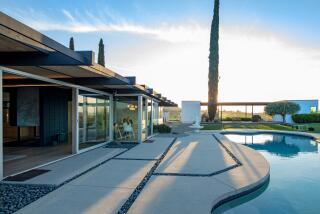Museums : Large Estates Are Little Gems as Windows on a Lost Way of Life
- Share via
For a brief period early in the century, country estates for wealthy Americans multiplied quickly. But by the 1950s, they were white elephants.
Servants were scarce and upkeep was costly, so much of the land was broken into smaller parcels for development, and the houses were torn down or greatly altered.
More from luck than planning, some survived as museums, offering examples of craftsmanship and decoration and a window on a way of life reserved for the wealthy. One such is Reynolda House, built with tobacco money in Winston-Salem, N.C.
The 64-room white stucco mansion, outbuildings and gardens on 1,067 acres were built between 1912 and 1917 for R.J. and Katharine S. Reynolds. The house, on about 30 acres, has been a museum since 1965. About 10 years before, Wake Forest University was deeded 350 acres of the estate and moved its campus from the hamlet of Wake Forest not far from Durham.
When it was new, Reynolda was literally a world of its own. There were a model farm and dairy, extensive ornamental gardens, polo grounds, a man-made lake and a church, school and post office in a village where employes lived. Reynolda House was remodeled in the 1930s and remained a family home through the early 1960s.
“What saved Reynolda is that the family that owned it had the money to keep it and then turned it into an art museum,” says Nicholas Bragg, museum director.
The collection at the Reynolda House Museum of American Art was donated by various Reynolds foundations as well as outsiders. It includes 135 pieces from 1755 to the present and is displayed in rooms that retain their original character and, in some cases, furniture.
Visitors--there are about 75,000 annually--can tour at their own pace, concentrating on art or furnishings as they prefer.
Reynolda House, less ostentatious on the outside than many country houses of the era, was designed by Philadelphia architect Charles Barton Keen.
He was well-known as a designer of grand yet comfortable structures incorporating elements of traditional American farm buildings. The house seems to nestle in the setting as it is glimpsed from a long driveway that winds through acres of manicured lawn.
The interior is grand. In the reception hall, living room and dining room, there are fluted pilasters with Corinthian, Ionic or Doric capitals, as well as paneling, carved moldings, rosettes and plaques in plaster or wood. Most major rooms have marble fireplaces, and the walls of the two-story reception hall are faced with limestone.
The house is outfitted with three kitchens, two dumbwaiters, 14 bathrooms and a pipe organ. An indoor recreation area includes a swimming pool, bowling alley, Art Deco-style bar, squash court, shooting gallery and table tennis and billiards rooms.
The architect ordered the costliest method of painting for the main rooms: so-called French polishing in which at least seven coats of paint were put down, each sanded before the next, and the final coat rubbed by hand to an eggshell gloss.
Some of the best-known carriage trade companies supplied furnishings: lighting fixtures and fireplace accessories from E.F. Caldwell & Co. of New York, cast iron balcony railing from Samuel Yellin of Philadelphia, cabinetry and probably woodwork from Irving & Casson-A.H. Davenport of Boston.
Barbara Millhouse, the museum’s president, is a granddaughter of the original owners and spent time in the mansion as a child. She and Bragg, the director, are working to refurbish one bedroom to its original decor.
In the absence of written plans or photographs, they look for clues in unlikely places. One was hidden in the canopy bed. Beneath an outer covering of muslin was a fragment of embroidered silk. Millhouse wants to have the fabric copied. The delicate question is whether to match the canopy and window curtains.
“One expert told us these always matched,” she says, “and another said that they never did in this period.”
The Reynolda House museum is open Tuesday through Sunday year-round, offering seminars on historic houses and American art, literature and music. Each summer it is host to American Foundations, a six-week, college-level program in which students examine a work of art in depth and, to a lesser extent, the music and literature of the period. For further information: Reynolda House Museum of American Art, P.O. Box 11765, Winston-Salem, NC 27116. (910) 725-5325.
More to Read
Sign up for The Wild
We’ll help you find the best places to hike, bike and run, as well as the perfect silent spots for meditation and yoga.
You may occasionally receive promotional content from the Los Angeles Times.






